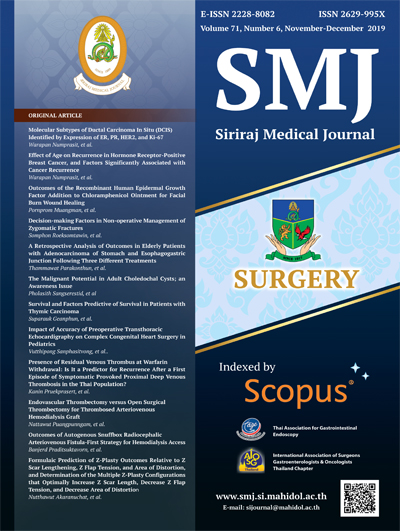Outcomes of Autogenous Snuffbox Radiocephalic Arteriovenous Fistula-First Strategy for Hemodialysis Access
DOI:
https://doi.org/10.33192/Smj.2019.74Keywords:
Arteriovenous fistula; snuffbox arteriovenous fistula; hemodialysis; vascular access for hemodialysis; AVFAbstract
Objective: An autogenous arteriovenous fistula (AVF) has been recommended as the first-line hemodialysis access option. A distal radiocephalic (snuffbox) arteriovenous fistula (SBAVF), the most distally located AVF, provides an extended vascular access area, allows future AVF correction in the proximal part, and offers relatively easy surgical access. This study aimed to evaluate the outcomes of patients who had SBAVFs as their first option for dialysis access.
Methods: The medical-record electronic database of Siriraj Hospital, Bangkok, Thailand, was retrospectively reviewed to evaluate the outcomes of patients receiving SBAVFs July 2013-December 2016 with over 12 months of follow-up.
Results: Of 39 patients, SBAVFs were successfully created in 33 patients (84.6%). Early thrombosis was observed in 1 patient. Steal syndrome, distal thrombosis, and complications of high-venous flow were not detected. The primary, primary-assisted, and secondary patency rates at 12 months were 60.6%, 81.8%, and 100%, respectively, and at 24 months were 51.5%, 72.7%, and 97.0%, respectively. Diabetes showed a significant correlation with failed AVF maturation, and venous diameters under 2.5 mm significantly reduced the 1-year primary patency. SBAVFs were successfully created in 9/12 patients who had a borderline venous size (< 2.5 mm), resulting in the AVF creation rate improving from 66.7% to 89.7%.
Conclusion: Autogenous distal radiocephalic (snuffbox) arteriovenous fistula is a feasible first-line option, especially for young, non-diabetic patients who are not in urgent need of hemodialysis. This strategy could also enhance the possibility of autogenous AVF creation in patients with a borderline venous size.
Downloads
Published
How to Cite
Issue
Section
License
Authors who publish with this journal agree to the following conditions:
Copyright Transfer
In submitting a manuscript, the authors acknowledge that the work will become the copyrighted property of Siriraj Medical Journal upon publication.
License
Articles are licensed under a Creative Commons Attribution-NonCommercial-NoDerivatives 4.0 International License (CC BY-NC-ND 4.0). This license allows for the sharing of the work for non-commercial purposes with proper attribution to the authors and the journal. However, it does not permit modifications or the creation of derivative works.
Sharing and Access
Authors are encouraged to share their article on their personal or institutional websites and through other non-commercial platforms. Doing so can increase readership and citations.















